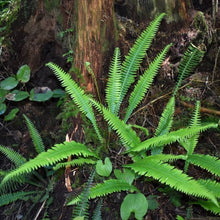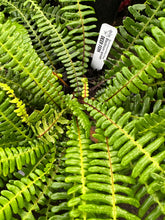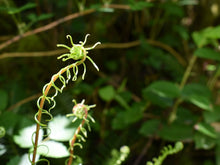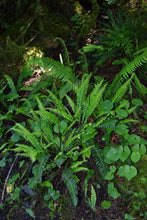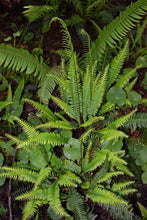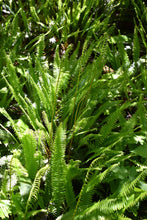
Blechnum spicant (Struthiopteris spicant)
Deer fern, also known as hard fern, brings grace and function to woodland shade gardens. Its first-year upright fronds add strong architectural lines to the garden and striking contrast to it's gentle texture. Tufts of new bright green or copper-colored fronds rise up in spring, above last season’s soft shamrock or deep forest green growth. A thriving patch of deer fern is a coveted addition to any shade garden.
- Plant type/canopy layer: evergreen, perennial, fern
- Size at maturity: 1'-3' tall, up to 2' wide
- Light requirements: full shade, part sun/part shade
- Moisture requirements: moist to wet soil
- Bloom time: n/a
- Growth rate/ease: slow growth rate, moderately difficult to grow
- Wildlife support: overall plant provides year-round refugia habitat for birds, amphibians, small mammals and insects, bird nesting material and is a valuable forage plant for deer, Mountain Goat, Bighorn Sheep, elk, moose, and caribou
- Native habitat/range: grows in shaded moist to wet forests, shady road banks, stream banks, and bogs, up to 2000m, in many areas around the world including Europe, northern Asia, Japan and in western North America. In our neck of the woods, it grows from southern Alaska to the central California coast; mostly west of the Cascades, but it also reaches east to the Idaho panhandle. Portland Plant List - yes.
- Special features & uses: evergreen; groundcover; edible (as emergency food); medicinal; deer resistant
Gardening with Deer Fern: Deer fern grows best in moist to wet evergreen or semi-evergreen forests and/or along streambanks, nestled in the soft, crumbly soil that comes from centuries of fallen detritus, and the symbiotic support of a real forest - but it can find home in your urban or suburban garden given adequate shade and/or moisture. Tuck it into under native evergreen trees and other moist, mossy areas rich with organic matter and well-protected by a nice thick layer of fallen leaves that will help retain moisture and be broken down by fungus and microscopic organisms, slow-releasing soil nutrients over time. Excellent companion plants include vine maple, Indian plum, evergreen huckleberry, inside-out flower, oxalis, alumroot, trillium, sword fern, salal, vanilla leaf, piggyback plant, foam flower, and many others. Deer fern has also been used as a houseplant.
Photo Credits: Nikkie West, Sparrowhawk Native Plants






